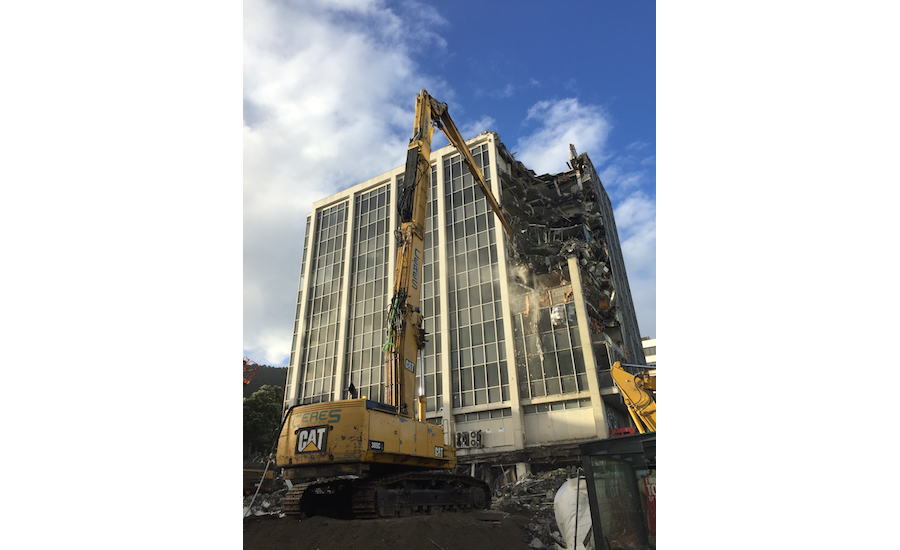Up to 15 high-rise buildings in Wellington, New Zealand’s capital, face an uncertain fate following a Nov. 14 earthquake that measured 7.8 magnitude earthquake on the Richter scale. Crews are at work demolishing structure deemed to be at risk of collapse and engineers are assessing other compromised buildings nearby, including a car park and cinema complex.
The quake severely damaged a nine-story building at 61 Molesworth Street in the central business district. Demolition commenced days after delays caused by gale force winds and other weather issues. The reinforced concrete framed building suffered extensive shear cracking. As a safety measure, officials evacuated neighboring premises, including the Red Cross, the National Library and the Thai Embassy. All will remain closed until 61 Molesworth has been razed. Further demolitions are expected to take place after the Christmas holidays.
The evacuations immediately affected between 10,000 and 15,000 office workers, as engineers explored options ranging from demolition to repairs. At the end of November, Mike Scott, Wellington City Council general manager for building compliance and consents at Mike Scott, said cordons around the Molesworth Street building could be reduced in early December and normality restored in unaffected buildings. He said the city was keen to get the area back open for nearby businesses. Scott says that most buildings performed as expected, with no catastrophic failure causing loss of life.
The list of buildings undergoing assessment rises daily and includes both privately owned and government offices in the capital city. Officials closed several key buildings following the quake and its aftershocks, including the government’s Statistics House, the Bank of New Zealand Harbour Quays building, Defence House, the High Court and the Greater Wellington Regional Council building. Engineers are assessing a Tennyson Street apartment building, Courtenay Central and Archives NZ to determine their fate.
The Kaikoura earthquake was New Zealand’s biggest since the magnitude 7.8 Dusky Sound jolt in 2009, and bigger than those in September 2010 and February 2011. The 2011 temblor registered 6.3 on the Richter scale and claimed 185 lives in Christchurch on the South Island.
While scientists continue to review seismic, satellite and GPS data to try and understand the complexities of the North Canterbury quake—a complex rupture sequence that produced ground-shaking that lasted for about two minutes and was felt throughout the country. It was centered east of Hanmer Springs at a depth of 15 km.
The most severe shaking occurred about 50 seconds after the quake started. Seismic instruments recorded nearly 900 aftershocks in the 48 hours after the main shock. They are expected to continue for months. GNS scientists estimate there could be up to 100,000 quake-triggered landslides in North Canterbury and southern Marlborough. The largest, on the south side of the Clarence River mouth, is estimated to be one million cubic meters.
Wellington City Council engineers are continuing to keep an eye on buildings around the city that have been damaged or deemed unsafe.
Dr. Charles Clifton, an associate professor of civil engineering at the University of Auckland, has extensive experience in building design for seismic locations. He says the latest shaker caused so much disruption because the horizontal acceleration was greater than that experienced during the fatal Canterbury earthquakes further south five years ago, which destroyed many buildings in the central business district in Christchurch and its surrounds.
“In Wellington, there are more high-rise buildings, and the quake appears to have affected a number of modern, flexible buildings, while shorter, stiffer buildings appear to have performed well. We’ve been monitoring steel framed buildings and those with composite floors, and they appear to have emerged in better shape,” he says.
Despite the damage to many Wellington buildings, Clifton says any further modification of building regulations is unlikely. “Wellington has a history with earthquakes. The trend is to design for controlled damage. Life safety is the key. There is always a trade-off in terms of strength, but designers work to a damageability threshold,” he says.
Swaroop Gowda is overseeing the demolition of the Molesworth Street building for contractor Ceres Environmental. The company shipped its Caterpillar 385 long reach excavator from the U.S. to New Zealand to carry out numerous large demolition contracts after the Canterbury earthquakes. It is similarly being used in Wellington. Ceres owner David McIntyre says the Christchurch experience was a valuable learning exercise and his company is taking the message to other earthquake-prone cities worldwide.



Post a comment to this article
Report Abusive Comment